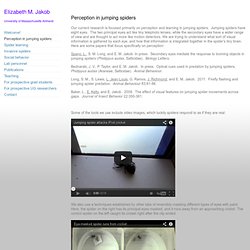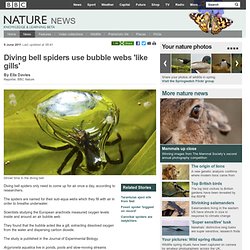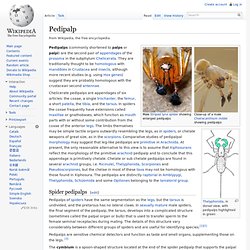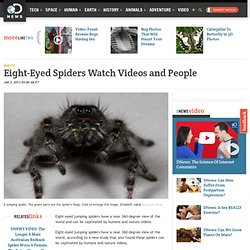

Elizabeth M. Jakob University of Massachusetts Amherst: Perception in jumping spiders. Our current research is focused primarily on perception and learning in jumping spiders.

Jumping spiders have eight eyes. The two principal eyes act like tiny telephoto lenses, while the secondary eyes have a wider range of view and are thought to act more like motion detectors. We are trying to understand what sort of visual information is gathered by each eye, and how that information is integrated together in the spider's tiny brain. Here are some papers that focus specifically on perception: Spano, L., S.
Bednarski, J. Long, S. Baker, L., E. Some of the tools we use include video images, which luckily spiders respond to as if they are real: We also use a techniques established by other labs of reversibly masking different types of eyes with paint. Phidippus princeps. Spiders prefer "faux fireflies" (crickets next to an LED) next to a flashing light, off light, or steadily glowing light. Spider silk spun into violin strings. 4 March 2012Last updated at 19:59 ET By Jason Palmer Science and technology reporter, BBC News More than 300 spiders were used to generate the thousands of strands of silk making up each string A Japanese researcher has used thousands of strands of spider silk to spin a set of violin strings.

The strings are said to have a "soft and profound timbre" relative to traditional gut or steel strings. That may arise from the way the strings are twisted, resulting in a "packing structure" that leaves practically no space between any of the strands. The strings will be described in a forthcoming edition of the journal Physical Review Letters. Shigeyoshi Osaki of Japan's Nara Medical University has been interested in the mechanical properties of spider silk for a number of years.
In particular, he has studied the "dragline" silk that spiders dangle from, quantifying its strength in a 2007 paper in Polymer Journal. x73k9Db.jpg (800×600) Keegan's Best Photos from 2013. BBC Nature - Diving bell spiders use bubble webs 'like gills' 9 June 2011Last updated at 05:41 By Ella Davies Reporter, BBC Nature Dinner time in the diving bell Diving bell spiders only need to come up for air once a day, according to researchers.

The spiders are named for their sub-aqua webs which they fill with air in order to breathe underwater. Scientists studying the European arachnids measured oxygen levels inside and around an air bubble web. They found that the bubble acted like a gill, extracting dissolved oxygen from the water and dispersing carbon dioxide. The study is published in the Journal of Experimental Biology. Argyroneta aquatica live in ponds, pools and slow-moving streams across Europe and northern Asia. They are the only spiders that live their entire lives underwater, mating, laying eggs and catching prey from their webs. The silk webs are constructed among vegetation beneath the surface of the water. Continue reading the main story Spiders videos, news and facts "It required the tiny, oxygen-sensitive optodes to do what we did.
Pedipalp. Thelyphonida, in dorsal view, with pedipalps highlighted in green Spider pedipalps[edit] Pedipalps are sensitive chemical detectors and function as taste and smell organs, supplementing those on the legs. [3] The cymbium is a spoon-shaped structure located at the end of the spider pedipalp that supports the palpal organ.[1] The cymbium may also be used as a stridulatory organ in spider courtship.[4] References[edit] Savory, T. 1977.

External links[edit] Several close-up photos of a tarantula creating a sperm web - Brachypelma Vagans (Mexican Red-rump) Eight-eyed Spiders Watch. Eight-eyed jumping spiders have a near 360-degree view of the world and can be captivated by humans and nature videos.

Eight-eyed jumping spiders have a near 360-degree view of the world, according to a new study that also found these spiders can be captivated by humans and nature videos. The study, published in the latest Royal Society Biology Letters, presents a detailed look at how each of these spiders' eight eyes works. During the experiments, the researchers also discovered that the spiders sometimes become fixated on certain nature videos, as well as people. "Whereas many spiders, like black widows or the brown recluse, tend to avoid people, jumping spiders often seem quite fearless," co-author Elizabeth Jakob told Discovery News.
"I doubt that they mistake large objects, such as people, as prey, but they are certainly interested to know whether you pose a danger. " NEWS: Why Spiders Will Always Find You Two principal eyes face forward.